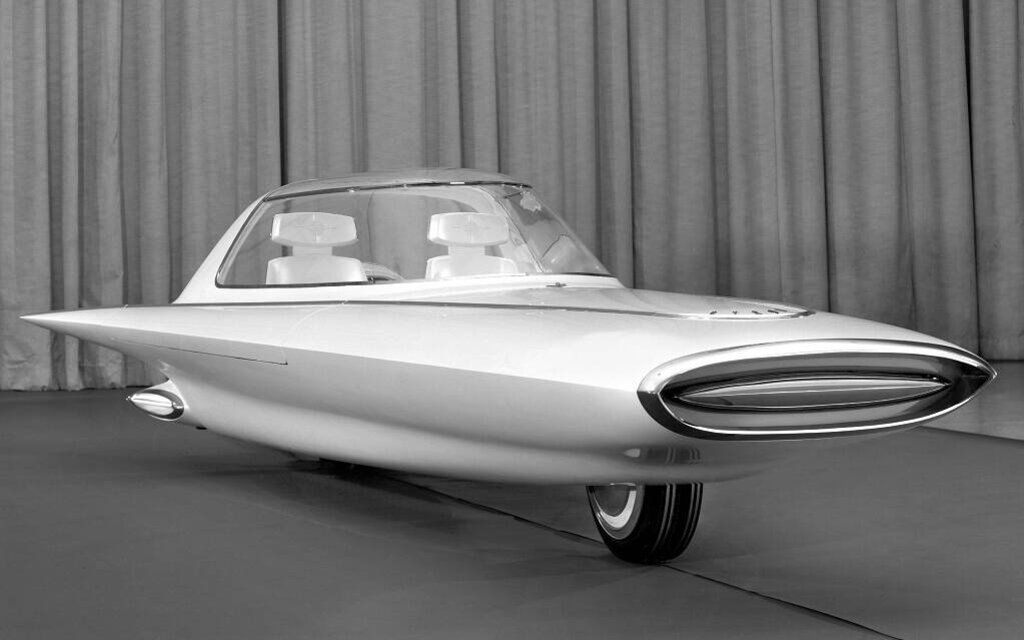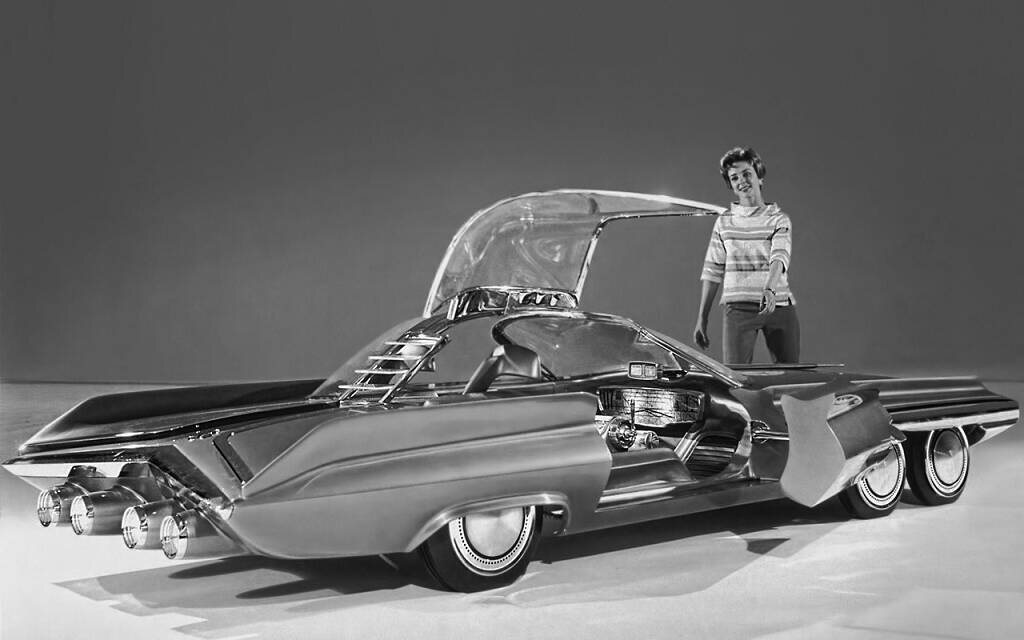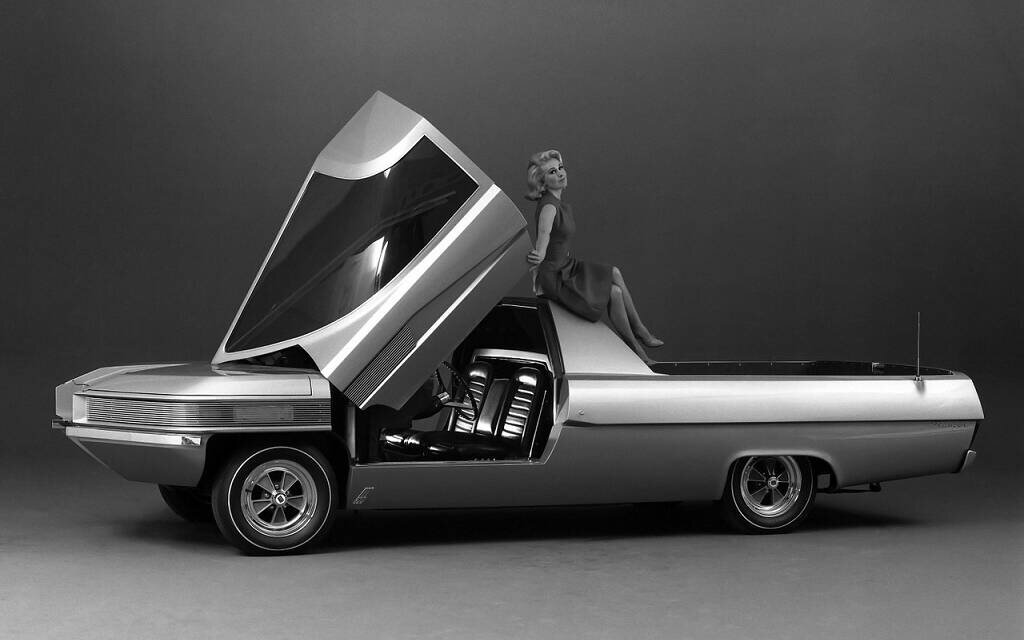Exotic propulsion systems, two- or six-wheeled cars, original composite materials, reconfigurable cabin, removable engine… Ford’s engineers and designers had no shortage of ideas.
They still had to be a little bit realistic…
Ford “Soybean car” 1941
Photo: Ford
Plastic, It’s Fantastic! At least that’s what Henry Ford thought. In his obsession with combining agriculture and industry, he saw soybeans as a magical plant. In the 1930s, he started a program for the production of plastic body panels made from soy fibers. The first drawings are made by Eugene T. Gregorie but Ford was apparently not satisfied. He then entrusts the project to Lowell E. Overly, who will be assisted by the chemist Robert A. Boyer (the latter will file in 1953 the first patent applications for imitation meat products made from soy).
A prototype was presented on August 13, 1941. It was based on a tubular chassis and used a 136 cubic inch (2.2 liter) V8 developing 60 horsepower. Installed on top are 14 quarter-inch-thick plastic body panels said to be made of soybean fibers, impregnated with phenoplast and formaldehyde (a technique relatively similar to the Duroplast panels of the East German Trabant 601s, but with cotton fibers). We do not know more because the formulation has never been revealed and would have disappeared today. The final weight is around 2,000 pounds (900 kg), almost 25% less than an equivalent car of the time. The Second World War will stop Ford’s project. In the aftermath of the conflict, the company is more concerned with ensuring its survival than experimenting. The prototype will be destroyed and work will cease.
1961 Ford Gyron

Photo: Ford
A 4-wheeled car is too commonplace. Three wheels, it’s already more interesting but still too simple. So why not two wheels? The idea is to optimize air penetration. It comes from Alex Tremulis, a designer who will have an extraordinary career. Prior to World War II, he was styling manager for Auburn-Cord-Duesenberg and worked for several coachbuilders. Following the bombing of Pearl Harbor, he joined the armed forces. After the conflict, he designed the lines of the 1948 Tucker before returning to Ford’s advanced styling studio. There, he can develop concepts around his passion: aerodynamics. He begins to make the first sketches of a two-wheeled car stabilized by a gyroscope.
The project took shape in 1959. Assisted by Syd Mead (genius illustrator) and McKinley Thompson (future designer of the 1966 Bronco), he built a full-scale model. quite a large gyroscope, the Gyron was finally presented at the 1961 New York Auto Show without this technology and with two retractable rear wheels for stability. The brochure states that “Ford’s stylists were guaranteed that a gyroscope under two feet would be sufficient to stabilize the vehicle”. Passengers access the interior through the roof, which lifts. They can then settle into two one-piece molded seats that surround a telephone to communicate outwards. No more steering wheel, it’s a rotary dial with two rings (one for speed, one for direction) that controls the car! The dashboard contains a screen with infrared vision. After the show, the Gyron is placed in Ford’s Rotunda, an exhibit center in Dearborn. It will burn with the building on November 9, 1962.
This is however not the end of the story. After leaving Ford in 1963 and establishing his own design company, Tremulis would continue to work on stabilized vehicles. In 1967, he presented the Gyro-X, a fully functional single-seater model powered by a Mini engine. The gyroscope, which rotates between 4,000 and 6,000 rpm, is located in front of the driver. The car still exists today and has been restored.
1958 Ford Nucleon

Photo: Ford
This prototype is absolute proof of the unshakable optimism of the 1950s. How about a car capable of driving 8,000 kilometers between two visits to the service station? The solution is the use not of a gasoline engine but of a nuclear reactor coupled to a steam engine. Obviously, no question of refueling. The rear blocks, which contain the radioactive core and all the insulation, are interchangeable at the station.
Ford suggests the reactor could be fusion or fission and even thinks it could be customized to the driver’s needs. Of course, the company leaves it to the engineers of the future to sort out the final details… such as radioactivity problems in the event of an accident… Unsurprisingly, the idea will never go further than a model at the 3/8th scale.
Ford Seattle-ite XXI 1962

Photo: Ford
This concept was developed to be presented at the Seattle World’s Fair in 1962, hence its name. After exploring a two-wheeled car, Alex Tremulis went completely the other way for one of his latest designs for Ford: a 6-wheeled car! The four front wheels are steering and improve traction and braking. But the most interesting thing is that the entire front block is removable. It can be replaced to change the engine, which could be a fuel cell or a nuclear reactor… we come back to this! The powers envisaged by Ford range from 60 to 400 horsepower.
The controls (steering, brakes, accelerator) are connected to the passenger compartment by flexible couplings. The latter is not left out since it contains a screen for the ancestor of the GPS while the steering wheel disappears in favor of control levers. In order not to die of heat under this bubble of glass, openable shutters are installed at the back. A brochure will be distributed during the exhibition but, logically, this concept will not go beyond the 3/8 model stage.
1966 Ford Ranger II

Photo: Ford
From the 1960s, Ford understood that vans were gradually becoming machines for all uses and not just for work. Originally developed by Syd Mead and based on an F-250 chassis with a wheelbase of 120 inches (3.05 meters), the Ranger II features hydraulically opening doors integrated into the windshield. However, this is not the most amazing feature of the concept. In fact, to go from a 2-seater vehicle with an 8-foot-long box to a 4-seater for the weekend, the rear part of the cabin moves back 45 centimeters, an additional roof section rises and two additional seats fold out.
The box has a walnut floor, courtesy lights and aluminum loading rails. The interior includes bucket seats and power steering, tilt steering wheel, AM/FM radio and air conditioning. The engine is a 390 cf (6.4 litre) V8 with three carburetors mated to a 3-speed SelectShift Cruise-O-Matic automatic transmission.
The Ranger II will be shown at the Detroit Auto Show in November 1966. The following year it will be modified and presented as the Ranger III. Ford will add an automatically opening hood from the inside.
Mercury Wrist-Twist 1965

Photo: Ford
Many have tried to reinvent the wheel, but in 1965 Robert J. Rumpf, a Ford engineer, attempted to reinvent the steering wheel. The system was demonstrated in 1965 on Mercury Park Lane convertibles. The two small flywheels are synchronized. They control chains which pass through the two fixed arms and are mounted on the steering shaft. The advantage is easier access, better visibility and long-distance driving comfort by allowing you to rest your arms on the armrests.
The difficulty is that in the event of loss of hydraulic assistance, it becomes absolutely impossible to turn. To counter it, the engineers added a second hydraulic assistance pump. Imagine the head of the accountants! If Ford did consider marketing it for a while, the Wrist-Twist was above all a solution in search of a problem.
